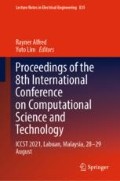Abstract
The study presents an attempt to analyse how social media netizens in Malaysia responded to the calls for “Social Distancing” and “Physical Distancing” as the newly recommended social norm was introduced to the world as a response to the COVID-19 global pandemic. The pandemic drove a sharp increase in social media platforms’ use as a public health communication platform since the first wave of the COVID-19 outbreak in Malaysia in April 2020. We analysed thousands of tweets posted by Malaysians daily between January 2020 and August 2021 to determine public perceptions and interactions patterns. The analysis focused on positive and negative reactions and the interchanges of uses of the recommended terminologies “social distancing” and “physical distancing”. Using linguistic analysis and natural language processing, findings dominantly indicate influences from the multilingual and multicultural values held by Malaysian netizens, as they embrace the concept of distancing as a measure of global public health safety.
Access this chapter
Tax calculation will be finalised at checkout
Purchases are for personal use only
References
Aisopos F, Papadakis G, Varvarigou T (2011) Sentiment analysis of social media content using N-gram graphs. In MM’11—Proceedings of the 2011 ACM multimedia conference and co-located workshops—WSM’11: 3rd ACM social media workshop
Al-Rfou R, Perozzi B, Skiena S (2013) Polyglot: distributed word representations for multilingual NLP. In: CoNLL 2013—17th conference on computational natural language learning, proceedings
Babulal V, Othman NZ (2020) Sri Petaling Tabligh gathering remains Msia’s largest COVID-19 cluster. New Straits Times, (September). Retrieved from: https://bit.ly/tabligh_gathering
Batrinca B, Treleaven PC (2014) Social media analytics: a survey of techniques, tools and platforms. AI Soc. https://doi.org/10.1007/s00146-014-0549-4
Bird S (2006) NLTK. COLING-ACL ‘06: proceedings of the COLING/ACL on Interactive presentation sessions July 2006, pp 69–72
Cavalieri DC, Palazuelos-Cagigas SE, Bastos-Filho TF, Sarcinelli-Filho M (2016) Combination of language models for word prediction: an exponential approach. IEEE/ACM Trans Audio Speech Lang Process
Chang YC, Ku CH, Chen CH (2019) Social media analytics: extracting and visualising Hilton hotel ratings and reviews from TripAdvisor. Int J Inf Manage. https://doi.org/10.1016/j.ijinfomgt.2017.11.001
Chen Y, Skiena S (2014) Building sentiment lexicons for all major languages. In: 52nd annual meeting of the association for computational linguistics, ACL 2014—proceedings of the conference. https://doi.org/10.3115/v1/p14-2063
Devlin J, Chang MW, Lee K, Toutanova K (2019) BERT: pre-training of deep bidirectional transformers for language understanding. In: NAACL HLT 2019—2019 Conference of the North American chapter of the association for computational linguistics: human language technologies—proceedings of the conference
Dredze M, Broniatowski DA, Hilyard KM (2016) Zika vaccine misconceptions: a social media analysis. Vaccine 34(30):3441
Fan W, Gordon MD (2014) The power of social media analytics. Commun ACM. https://doi.org/10.1145/2602574
Friedman N, Geiger D, Goldszmidt M (1997) Bayesian network classifiers. Mach Learn. https://doi.org/10.1002/9780470400531.eorms0099
Han J, Kamber M, Pei J (2012) Data mining: concepts and techniques. Morgan Kaufmann. https://doi.org/10.1016/C2009-0-61819-5
Hart M (2020) WHO changes “social distancing” to “physical distancing”. Nerdist. Retrieved from: https://nerdist.com/article/social-distancing-changed-physical-distancing/
Hofmann T (2001) Unsupervised learning by probabilistic latent semantic analysis. Mach Learn. https://doi.org/10.1023/A:1007617005950
Husein Z (2018) Malaya, natural-language-toolkit library for Bahasa Malaysia, powered by deep learning tensorflow. Github. https://github.com/huseinzol05/malaya
Juan SS, Ismail MFC, Ujir H, Hipiny I (2020) Language modelling for a low-resource language in Sarawak, Malaysia. LNEE 619:147–158. https://doi.org/10.1007/978-981-15-1289-6_14
Kaos J Jr (2020) Health DG : 171 COVID-19 cases linked to church gathering, wedding ceremony. The Star. Retrieved from https://bit.ly/thestar_covid19
Karafi M, Cernock JH (2010) Recurrent Neural network language modeling, pp 1045–1048. https://doi.org/10.1021/jp056727x
Kaur PC, Ghorpade T, Mane V (2016) Topic extraction and sentiment classification by using latent dirichlet Markov allocation and sentiwordnet. In: ACM international conference proceeding series. https://doi.org/10.1145/2979779.2979865
Kayes ASM, Islam MS, Watters PA, Ng A, Kayesh H (2020) Automated measurement of attitudes towards social distancing using social media: a COVID-19 case study. Preprints, April. https://doi.org/10.20944/preprints202004.0057.v1
Kibriya AM, Frank E, Pfahringer B, Holmes G (2004) Multinomial naive bayes for text categorisation revisited. Lect Notes Artif Intell (Subseries of Lecture Notes in Computer Science). https://doi.org/10.1007/978-3-540-30549-1_43
Lee I (2018) Social media analytics for enterprises: typology, methods, and processes. Bus Horiz. https://doi.org/10.1016/j.bushor.2017.11.002
Mat NFC, Edinur HA, Razab MKAA, Safuan S (2020) A single mass gathering resulted in massive transmission of COVID-19 infections in Malaysia with further international spread. J Travel Med 27(3):1–4
Nazar R, Renau I (2012) Google Books N-gram Corpus used as a Grammar Checker. In: Proceedings of the EACL 2012 workshop on computational linguistics and writing
Öztürk N, Ayvaz S (2018) Sentiment analysis on Twitter: a text mining approach to the Syrian refugee crisis. Telemat Inform
Thakor P, Sasi S (2015) Ontology-based sentiment analysis process for social media content. In: INNS conference on big data, pp 199–207
Yang Z, Dai Z, Yang Y, Carbonell J, Salakhutdinov R, Le QV (2019) XLNet: generalised autoregressive pretraining for language understanding. Adv Neural Inf Process Syst
Zeng D, Chen H, Lusch R, Li SH (2010) Social media analytics and intelligence. IEEE Intell Syst 25(6). https://doi.org/10.1109/MIS.2010.151
Author information
Authors and Affiliations
Corresponding author
Editor information
Editors and Affiliations
Rights and permissions
Copyright information
© 2022 The Author(s), under exclusive license to Springer Nature Singapore Pte Ltd.
About this paper
Cite this paper
Juan, S.S., Saee, S., Mohamad, F. (2022). Social Versus Physical Distancing: Analysis of Public Health Messages at the Start of COVID-19 Outbreak in Malaysia Using Natural Language Processing. In: Alfred, R., Lim, Y. (eds) Proceedings of the 8th International Conference on Computational Science and Technology. Lecture Notes in Electrical Engineering, vol 835. Springer, Singapore. https://doi.org/10.1007/978-981-16-8515-6_44
Download citation
DOI: https://doi.org/10.1007/978-981-16-8515-6_44
Published:
Publisher Name: Springer, Singapore
Print ISBN: 978-981-16-8514-9
Online ISBN: 978-981-16-8515-6
eBook Packages: Intelligent Technologies and RoboticsIntelligent Technologies and Robotics (R0)

